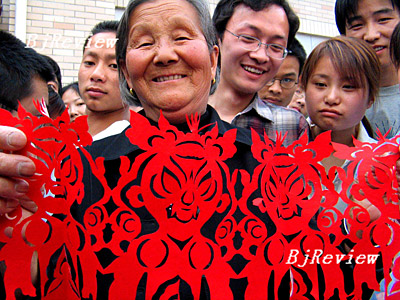
"I still remember how as a child I watched my mother making paper cuts and sewing under the light of an oil lamp beside my bed. She looked mysterious when she held a paper cut in front of her face to amuse me," said Liu Jieqiong, a rural woman from Yanchuan County, in northwest China's Shaanxi Province.
"It wasn't until I became a wife and mother and led a life like my mother that I began to understand her. She was a strong woman," she added.
The Chinese folk art of paper cutting, which uses scissors and knives to cut out patterns on paper, has been a major source of decoration in Chinese farm households for more than a thousand years, and has become an important form of artistic expression for farmers, especially women.
"I started to learn paper cutting all by myself when I was a little girl. I kept practicing and focusing on the skills. When I reached my teens, I was no stranger to this art form," said the "strong woman" Gao Fenglian, Liu's mother, who at 73 is lauded as a model among the paper cutting artists of north China.
Gao's works reach across a wide range of subject matter. They recall ancient myth and speak to the reality of modern life. All are rich in artistic value and aesthetic sensibility, yet they remain earthy and bold and are crafted in a style all her own.
The paper cut master
Gifted with the flair for paper cutting, Gao is hailed as the master in her village. During the local festivals Gao is invited to show off her polished scissors-cutting skills. Images created under her scissors seem to exude vitality. She holds a deep reverence for the tradition but refuses to be confined by stereotypes. Her designs remain firmly rooted in the old ways yet they reveal a touch of contemporary individuality.
Jin Zhilin, a professor of the Central Academy of Fine Arts, said, "Taking this work from her as an example: She wants to express the vitality and flourish of the Chinese nation. The clock on the archway is accompanied by a lion and a dragon from primitive times. The horseback rider below serves as the door-god. All these patterns, the archway, the ornamental columns, lions, dragons, and phoenixes symbolize the perfect union of sky and earth. It speaks to the vitality of the nation that is the essence of Chinese philosophy."
Gao is a born artist in the eyes of many. She never went to school, not for one day, though she's lauded as the one of the finest paper cut artists of her time. She's a typical rural woman who is kept busy doing everyday chores like laundry and cooking. She takes up her paper cutting implements for a little relaxation.
Gao's works made their first public appearance at a paper cutting exhibition in the mid-1980s. Soon critics nationwide were intrigued. In 1995, Gao competed with over 80 paper cutting artisans at a local competition. She won top prize for her entry "The Fairy Lady." That February, she was awarded the prize for "Special Contribution" at an invitational competition in east China's Zhejiang Province. Two months later, Gao was given another honor and won international acclaim when the United Nations Education, Science and Cultural Organization (UNESCO) awarded her the distinction of "Master of Folk Art and Crafts."
Artist to preserver
What makes the folk artist even more extraordinary was that in 2005 she alone invested 300,000 yuan to establish the first individual art gallery in her home town, under her name. "I made paper cuttings and hire workers to carve them onto the walls. That took a lot of work," said Gao.
